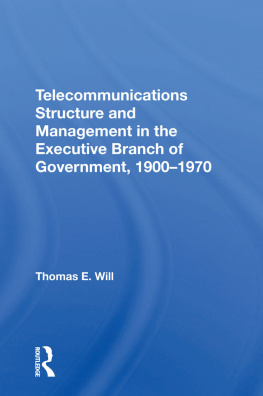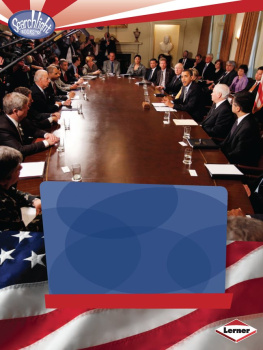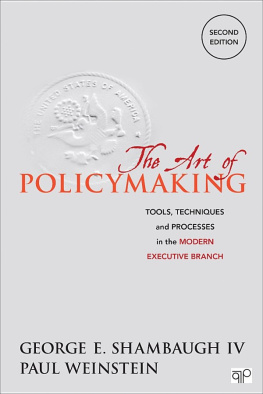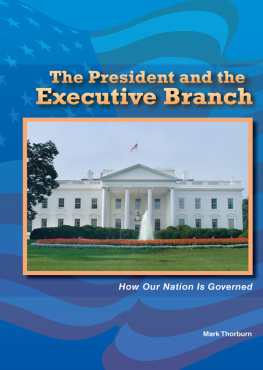Telecommunications Structure and Management in the Executive Branch of Government, 1900-1970
Westview Replica Editions
This book is a Westview Replica Edition. The concept of Replica Editions is a response to the crisis in academic and informational publishing. Library budgets for books have been severely curtailed; economic pressures on the university presses and the few private publishing companies primarily interested in scholarly manuscripts have severely limited the capacity of the industry to properly serve the academic and research communities. Many manuscripts dealing with important subjects, often representing the highest level of scholarship, are today not economically viable publishing projects. Or, if they are accepted for publication, they are often subject to lead times ranging from one to three years. Scholars are understandably frustrated when they realize that their first-class research cannot be published within a reasonable time frame, if at all.
Westview Replica Editions are our practical solution to the problem. The concept is simple. We accept a manuscript in camera-ready form and move it immediately into the production process. The responsibility for textual and copy editing lies with the author or sponsoring organization. If necessary we will advise the author on proper preparation of footnotes and bibliography. We prefer that the manuscript be typed according to our specifications, though it may be acceptable as typed for a dissertation or prepared in some other clearly organized and readable way. The end result is a book produced by lithography and bound in hard covers. Initial edition sizes range from 400 to 600 copies, and a number of recent Replicas are already in second printings. We include among Westview Replica Editions only works of outstanding scholarly quality or of great informational value, and we will continue to exercise our usual editorial standards and quality control.
Telecommunications Structure and Management in the Executive Branch of Government, 19001970
Thomas E. Will
In early 1970 President Richard M. Nixon created a new executive office, the Office of Telecommunications Policy (OTP), and appointed Dr. Clay T. Whitehead as OTP's first director. (Whitehead had previously been on the staff of Peter Flanigan, a presidential assistant responsible for telecommunications policy at the White House.) What was the motivation behind this action? Were political interests being served? With what results? Thomas Will believes that these and other questions must be raised in view of the history of the Nixon administration. In an attempt to answer them, he examines the development of telecommunications policy in the executive branch from 1900 to 1970.
Dr. Will reviews the early executive branch involvement in radio telecommunications, the Radio Act of 1927 and the Communications Act of 1934, the technological advance of radio telecommunications and its effect on the executive branch before and after World War II, the. appointments of telecommunications advisors to presidents from 1951 to 1967, and the creation of the President's Task Force in 1967 to deal with the problems created by an inherently limited radio spectrum. He traces the steps taken to create the OTP and analyzes the extent to which the office reflected a traditional progression of executive branch telecommunications authority. His study and conclusions are directly and essentially relevant to the current debate on telecommunications policy.
Thomas E. Will is associate publisher of Telecommunications magazine. He was previously a policy analyst with the Office of Telecommunications, U.S. Department of Commerce. Dr. Will holds a Ph.D. from the University of Wisconsin.
Telecommunications Structure and Management in the Executive Branch of Government, 1900-1970
Thomas E. Will
First published 1978 by Westview Press, Inc.
Published 2019 by Routledge
52 Vanderbilt Avenue, New York, NY 10017
2 Park Square, Milton Park, Abingdon, Oxon OX14 4RN
Routledge is an imprint of the Taylor & Francis Group, an informa business
Copyright 1978 Taylor & Francis
All rights reserved. No part of this book may be reprinted or reproduced or utilised in any form or by any electronic, mechanical, or other means, now known or hereafter invented, including photocopying and recording, or in any information storage or retrieval system, without permission in writing from the publishers.
Notice:
Product or corporate names may be trademarks or registered trademarks, and are used only for identification and explanation without intent to infringe.
Library of Congress Catalog Card Number: 78-19719
ISBN 13: 978-0-367-28980-5 (hbk)
Introduction
It is common knowledge that telephone, radio, television, and radar are telecommunication technology that assume important functions in everyday life. It is this dependence on communications that increases societal demand of telecommunication services. Yet, in regard to radio telecommunication demand for service may exceed the supply of channels available. Radio is a limited natural resource because of its reliance upon finite space within the electromagnetic frequency spectrum.
This chapter is an attempt to explain the development of the wireless invention in the first half of the twentieth century and its concomitant effect on the executive branch. As technology changed in telecommunication, the structure of the executive was also altered. As the complexity of communications technology increased, the executive management of radio became more difficult.
In 1900, the executive branch handled wireless through the Secretary of the Navy; after World War II every member of the President's Cabinet was involved in radio. The following is a description of the evolution of radio within the executive branch from 1900 to 1948.
The Wireless Radio Comes to America, 1900
As the Nineteenth Century drew to a close, the British Navy was displaying a growing interest in more effective communications among ships of its fleet. Other countries, including the United States, had the same naval communication needs.
Guglielmo Marconi, an Italian citizen, applied for the wireless (radio) patent in Great Britain in 1896,
The parent Marconi company and its subsidiaries organized themselves to capitalize on its wireless patent, building shore stations to communicate with ships. Marine disasters anywhere speeded the Marconi wireless sales.
The life-saving aspects of wireless were constantly discussed, but its adoption also dovetailed with the needs of trade, the zeal for empire, and the burgeoning of military budgets.
However, the Marconi Company did not sell its wireless equipment outright. A royalty or leasing fee was attached to each American wireless purchase. Also Marconi had a monopoly on coastal transmitting stations. American wireless was thus subjected to foreign control. Since wireless was a strategic weapon, foreign ownership of this invention did not sit well with the American admiralty.
The effect of Marconi dominance became apparent in 1903. Prince Henry of Prussia, brother of the Kaiser, attempted to radio President Theodore Roosevelt after an American visit. The radio telegram intended for the White House was sent from the Prince's ship, S.S. Deutchland. Since the Prussian ship carried non-Marconi equipment, the Marconi radio receiving station at Nantucket refused to accept the message. to end such narrow restraints upon international communication.













